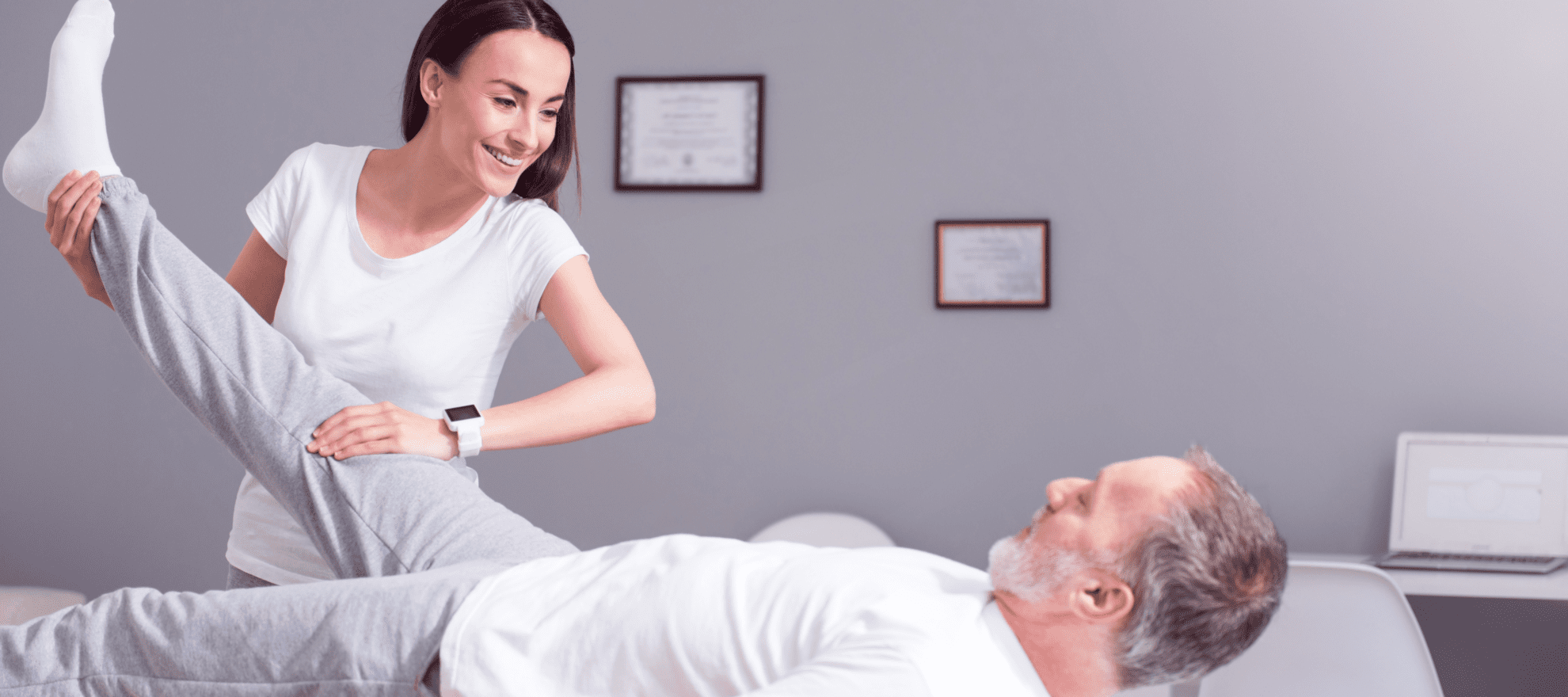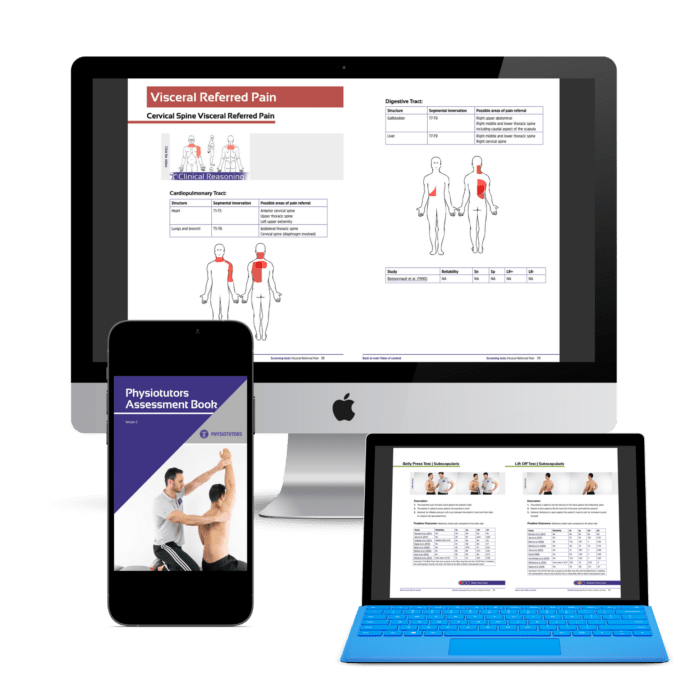Cluster of van der Wurff | SIJ Pain Provocation
Go to
Cluster of van der Wurff | Sacroiliac Joint Pain | SIJ Assessment
The cluster of van der Wurff is a test battery consisting of 5 SIJ provocation tests to determine if your patient’s pain is coming from the SI joint. It has a sensitivity of 85% and a specificity of 79% for 3 or more positive tests according to van der Wurff himself (2006). This means that 3 or more positive tests out of 5 are indicative for SIJ pain.
- Distraction test (Gapping test): For the distraction test, have your patient in supine-lying position with the affected side close to the side of the table. Then, stand next to the patient on the affected side and apply cross-armed pressure to the anterior superior iliac spines (ASIS) for about 5 seconds in a dorsal and lateral direction with the arms building up until around 25-30kg. Be careful that you don´t stretch your patient’s skin, which may cause discomfort. This test causes gapping anteriorly and compression on the posterior side.
- Compression test (Approximation test): For the compression test have your patient in side-lying position with the affected side up and the back toward the side of the treatment table. Hips are flexed to approximately 45°, and the knees are flexed to approximately 90°. Then, stand behind your patient, place your folded hands over the anterior edge of the iliac crest and applies a downward pressure for 5 seconds, building up the pressure to around 25-30kgs. This test provokes by creating compression anteriorly and gapping on the posterior side of the SIJ.
- Thigh Thrust test (Femoral Shear test): To perform the Thigh Thrust or Femoral Shear test, the subject lies supine with the contralateral leg extended. While you stand at the affected side, flexe the ipsilateral leg to approximately 90° hip flexion while the knee remains relaxed. Then, slightly adducts the femur and encloses the knee with folded hands. Apply a graded force through the long axis of the femur for 5 seconds and build up the pressure to about 25-30kg. This causes an anterior-to-posterior shear force to the sacroiliac joint on the same side.
- Gaenslen test (Pelvic Torsion test): For the Gaenslen test, have your patient in supine position with the affected side close to the edge of the treatment table. Guide your patient´s knees to his chest until the patient’s lower back assumes a physiologic lordosis. Then fixate the contralateral leg in slight hip abduction and maximal hip flexion. Then ask your patient to slowly lower his ipsilateral leg into hip extension and apply a light steady downward pressure of about 15kg for 5 seconds. This test will only be performed unilaterally on the affected side. It provokes the SIJ joint by creating a counternutation force on the ipsilateral SIJ.
- Patrick’s sign (Faber test): For the Patrick’s sign, have your patient in supine position and stand next to the subject on the affected side. Then your patient brings the ipsilateral knee into flexion with the medial side of the heel against the knee of the other leg. While you fixate the contralateral ASIS to ensure that the lower back remains in a neutral position, your patient lowers his ipsilateral leg toward the treatment table as far as possible while the foot remains in contact with the treatment table. At last, apply a light overpressure to your patient´s knee of about 15kg for 5 seconds. Similar to the distraction test, the Patrick’s test causes a gapping on the anterior side and compression on the posterior side of the ipsilateral SIJ.
Each of these 5 tests is positive if the patient’s familiar pain is provoked AND if this familiar pain was felt on the ipsilateral side in the gluteal region under vertebrae L5.
Another common test battery to diagnose a symptomatic sacroiliac joint is the Cluster of Laslett.
21 OF THE MOST USEFUL ORTHOPAEDIC TESTS IN CLINICAL PRACTICE

References
BUY THE FULL PHYSIOTUTORS ASSESSMENT BOOK
- 600+ Pages e-Book
- Interactive Content (Direct Video Demonstration, PubMed articles)
- Statistical Values for all Special Tests from the latest research
- Clinical Value Recommendation
- Detailed descriptions & searchable
- Currently on Version 6.0 – Free lifetime updates
- Available in 🇬🇧 🇩🇪 🇫🇷 🇪🇸 🇮🇹 🇵🇹 🇹🇷
- And much more!
ALL ORTHOPEDIC TESTS IN ONE PLACE


What customers have to say about the Assessment E-Book
- Vince199225/04/20The Assessment E-Book This book helped me in my studying for my exam and in assessing my first patients. Awesome! Also for beginners!Simon Pagitz06/04/20The Assessment E-Book It’s an amazing Compilation! Congrats to all the work you have put in there. You’ll propably find all the test’s you’ve been looking for with propper explaination and source to doublecheck for you self. definetly a must have for every student, but it will also help an experienced practioner. Im looking forward to the lifelong updates on the topics.
Great work, guys - Jordi Burrut27/10/19The Assessment E-Book A must-have for all physiotherapists, osteopaths and manual therapists. The authors conducted an extensive research on assessment tests in manual therapy. I find it very easy to read. The more I read the more I learn. Thank you!Josh07/07/19The Assessment E-Book This book is great! It is very structured and detailed. It works extremely well on my Macbook and iPad.
- Polo_soa15/02/19The Assessment E-Book The best way to spend 80euros. Totally worth it. The amount of work you put behind this must have been absolutely huge. Every physical or physiotherapist should own it.
Congrats guys you’ve done an incredible job.
I’ve learnd a lot of new things and my approach to therapy in general have totally changed.
In one word: amazing. Keep going guys ! Best wishes from france.


